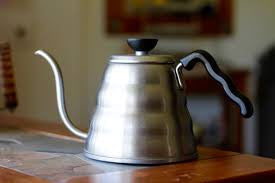
This article is the fourth in a series of four articles about manipulating the strength and flavor of coffee. The series covers the four major techniques for altering a coffee brew: Ratio, Grind, Time and Temperature.
Hot Enough For Ya?
Temperature might be the most neglected of the four major brew variables. For one thing, it has a small effect on brew strength compared to the other variables. For another thing, it ostensibly requires a thermometer to monitor, a tool that isn’t available in every home kitchen. But temperature has a profound effect on flavor and it is key to repeatability. If you’ve ever made a cup of coffee and wondered “Why is this different from the last time I made it?” I’d be willing to bet that temperature is the culprit.
Measuring Temperature
The easiest way to get water to the correct temp is to use a temperature controlled kettle like the Bonavita. Another option is to use a kitchen thermometer like this excellent model, or this solid, affordable one. But even without a thermometer or kettle there is a pretty easy way to find the temperature you’re looking for. Based on measurements we’ve taken in the roastery, water heated to boil in a kettle and then left at room temperature, uncovered, will lose heat at a rate of 1 degree F every 12 seconds. This means that it takes about 90 seconds for water to cool from boiling to 205 F. Though it’s not a perfect trick, it is a repeatable way to get water to a good brewing temperature without a thermometer.
Using Temperature to Change Your Brew
The chart below shows the results of six brews I did with the Colombia Auction Lot, which is one of the coffees currently in our single origin subscription pack. Each of the brews uses a temperature between 195 and 210, spaced 3 degrees apart. Aside from changing temperature, I used the same parameters for each brew: Chemex, 1:15 Ratio, 300g water, “9” grind on the EK43 grinder and a 3 minute 30 second brew time.
The chart shows Temperature graphed against TDS, which is Total Dissolved Solids. TDS measures brew strength. According to the SCAA, the ideal range for TDS of brewed coffee is 1.2-1.4%. The chart also indicates how flavors changed along with the intensity of the brew.

This experiment indicates there is only a loose relationship between Temperature and TDS. The three brews using the hottest temperature had an average TDS of 1.34% and the three cooler brews had an average of 1.33%. Although the brew strength didn’t change very much, the flavor change was very interesting because the coolest and the hottest brews were very similar, sharing chocolate notes and having a smooth finish. The two middle brews (201 and 204) were brighter and had much more present fruit notes. It seems that in the range of 200-205 F, acidity is emphasized, so fruit and floral flavors are prominent. Outside of that range, acidity is diminished and earthy/chocolate notes take over.
This article concludes the "Big Four" series on brew manipulation. Look out for more articles that will build on the knowledge we gained in this series.

Leave a comment